- Home
- Malaysia Trivia
- Malaysian Food Trivia
Malaysian Food Trivia
Fun Facts About Malaysian Food
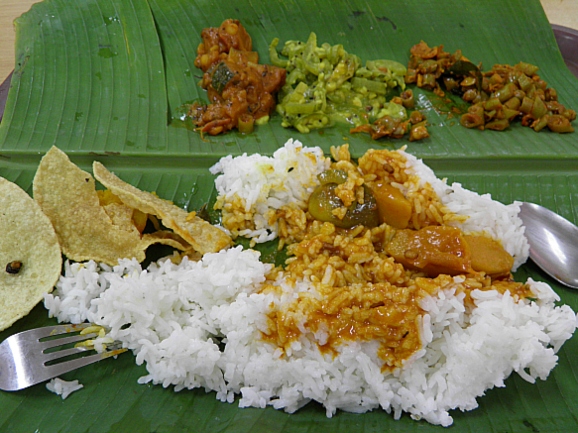
Welcome to my Malaysian Food Trivia page in which I give my take on some of Malaysia's favourite dishes and ingredients.
Malaysians are proud of their cuisine, and rightly so. With Malay, Indian, Chinese, Nyonya and other dishes on the menu the diner is spoilt for choice. Here are some of the things that make Malaysian food special:
BELACAN
Belacan (pronounced Blachan) is a pungent shrimp paste product and a staple ingredient in many Malaysian dishes. The production process involves soaking tiny prawns in brine and allowing the resulting paste to ferment and dry in the sun. It is sold in hard bricks. It should be cooked in a well ventilated kitchen and the odour might upset the neighbours if they are not Malaysian.
CENDOL
Ice Cendol is one of Malaysia’s most popular desserts. The key ingredient is the cendol itself, a starchy noodle coloured bright green with the juice of the pandan leaf. The dish consists of a pile of shaved ice, topped with cendol and red beans, swimming in syrup made from coconut milk and gula Melaka (palm sugar). It is a rather sweet dish but surprisingly refreshing and tasty.
CHEE CHEONG FUN
Malaysian foodies rave about this dish. The Cantonese name translates as Pig’s Intestine Noodles, which sounds neither halal nor appetizing but actually its name refers to its appearance, not the ingredients. The Malaysian version usually consists of fat, slippery rice flour noodles served with chilli sauce, red or brown sweet sauce, shrimp paste and topped with roasted sesame seeds and pickled green chillies on the side. It is a cheap and popular street food.
CHEESE
In common with their Asian neighbours, Malaysians traditionally have not been big cheese eaters. Annual cheese consumption per capita in 1970 was a paltry 0.03kg. This increased elevenfold to 0.33kg by 2011 as more Malaysians developed the taste for pizza, cheeseburgers, pasta and so on. No doubt this trend will continue but the country still has a long way to go to catch the Icelanders who consume a whopping 31kg of cheese per year. Perhaps a home grown cheese industry with local variations such as durian or belacan flavoured cheese might boost demand!
DIMSUM
Dim Sum is not quite the major event that it is in Hong Kong but it is still popular among the Malaysian Chinese who like their morning yum char. All the famous dishes like har gau (prawn dumplings), shiu mai (meat dumplings) and cha siu bau (steamed barbecued pork buns) are available from places like the upmarket Li Yen Restaurant at the Ritz Carlton, Kuala Lumpur.
FAST FOOD
All the usual western fast food favourites are available here and are very popular but traditional local versions are often faster, cheaper and more nutritious. Take otak-otak for example, a kind of kebab made from fish paste, spices and coconut milk, wrapped in banana leaf and grilled to perfection over charcoal. Simply delicious!
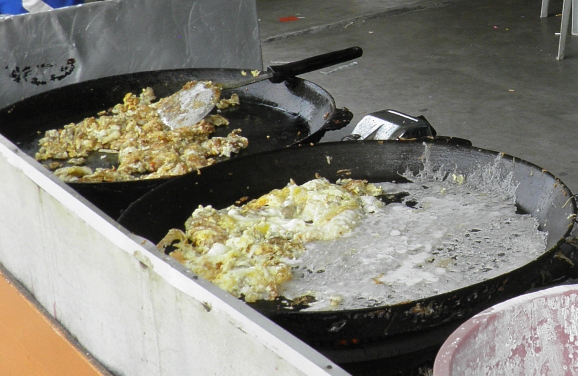
FRIED OYSTER OMELETTE
This is a popular dish, particularly at seaside resorts such as Crab Island (above photo) or in Melaka or Penang. It is an omelette made with tapioca flour (which adds a gooey consistency), eggs, oysters fried in chilli paste, garnished with chopped spring onions and served with a garlic chilli dipping sauce. This dish is sometimes fried in lard so it is non-halal.
GINGER
Ginger is a widely used herb in dishes such as Ginger & Scallion Fish, Drunken Chicken Ginger Broth, Pigs Trotters with Vinegar and Ginger, and Stir Fried Pork with Ginger. It is also used to make ginger tea, a drink which, according to the Holy Qur’an, will be served to the righteous in Heaven. Ginger is claimed to have many health benefits and its fat-burning properties are well known to Ayurvedic practitioners.
Many ornamental varieties are found in Malaysia and their exotic blooms can be seen in many forest parks. The white flowers have a powerful fragrance.
HOKKIEN MEE
One of the most popular hawker foods for the non-Muslim population is Hokkien Mee. It is a bowl of yellow or rice noodles, swimming in a strong, spicy prawn flavoured soup. It is served with water spinach and bean sprouts, garnished with slices of boiled egg, pieces of pork, fried shallots and chilli paste.
ICE KACANG
This popular dessert is made from red beans, sweet corn, attap chee (palm fruit) and grass jelly served in a bowl with shaved ice and topped with gula Melaka (palm sugar syrup) and a generous pouring of evaporated milk. Additional optional toppings might include ice cream, fresh fruit or colourful jellies. Sweet, tasty and refreshing.
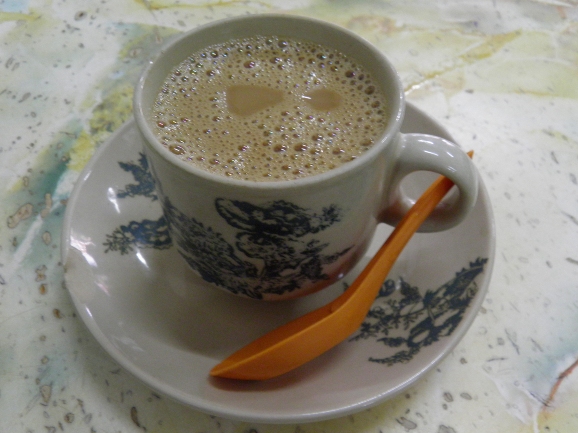
IPOH WHITE COFFEE
These days, the famous Ipoh White Coffee is available all over Malaysia - even in instant or 3-in-1 varieties. But to enjoy the authentic taste of the original recipe it is best to head to one of Ipoh’s humble kedai kopi shops such as Sun Yuan Foong. Here the beans are roasted by a special and secret method. The aromatic brew is sieved, mixed with both condensed and evaporated milk and served slightly frothy. It’s delicious but very sweet.
KOAY TEOW
Fried Koay Teow is one of the most popular local dishes. Flat rice noodles are wok fried with minced garlic and fresh prawns together with bean sprouts, chives, eggs and cockles, seasoned with soy sauce.
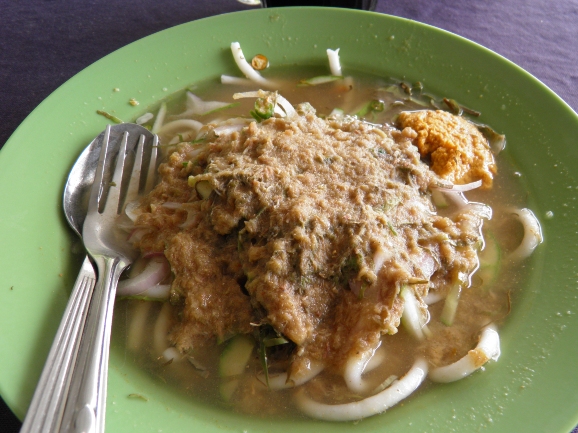
LAKSA TELUK KECHAI
Visitors to Kuala Kedah are recommended to try the local speciality, Laksa Teluk Kechai (pictured above). Laksa is a noodle dish in a spicy, sour soup. There are a number of different varieties such as Penang, Sarawak and Singapore. Teluk Kechai is the Kedah variant. There are a couple of restaurants which serve this dish located on the road between Alor Setar and Kuala Kedah. It is not the most appetizing looking dish but appearances can be deceptive. The mashed fish on top of the noodles is sardines or mackerel. The orange coloured condiment is fish roe mixed with coconut. The soup is not very spicy by Malaysian standards but strangely satisfying.
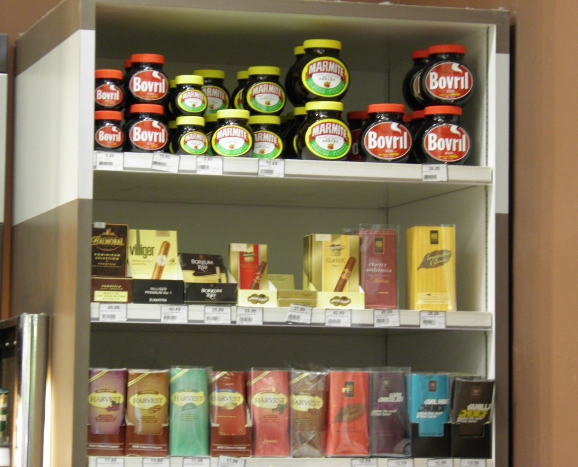
MARMITE
Strange as it may seem, Marmite is quite popular in Malaysia but as a cooking ingredient rather than for spreading on toast. It is used to flavour meat dishes or stirred into rice congee. Although it is made from brewer’s yeast it is certified Halal and 100% vegetarian. Oddly some supermarkets sell Marmite from the tobacco counter. Are they worried about shoplifters or is it just too addictive?
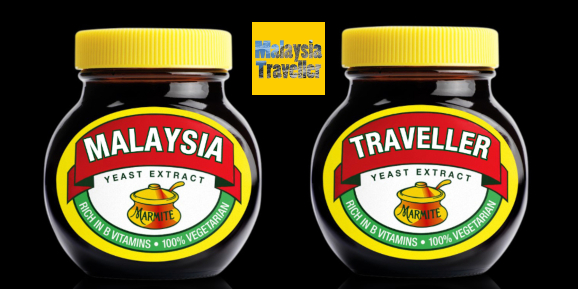
MEE GORENG
This is a fried noodle dish popular with the Indian Muslim community. It is typically prepared with blanched yellow noodles, bean sprouts, cuttlefish, soy bean cake, flour fritters, boiled potatoes and chillies. A spicy chilli and tomato sauce is stirred in to keep the noodles moist then garnished with chopped lettuce, ground peanuts and a slice of lemon.
MEAT
With so many ethnic groups, the topic of meat consumption in Malaysia is a complicated one with Muslims eating no pork, Hindus eating no beef and Chinese eating everything except those strict Buddhists who eat none. In 2010 the average Malaysian consumed 5.6kg of beef, 0.78kg of mutton, 19.9kg of pork (non-Muslim population only) and 35.0kg of poultry. They also consumed 295 eggs per capita.
MILK
Malaysians are not big milk drinkers and most of the milk sold in supermarkets is of the long life variety imported from New Zealand or Australia. Tinned sweetened evaporated and condensed milk is popular as is soya milk.
MUSHROOMS
The Mushroom Association of Malaysia (yes, there is one) informs us that there are 14,000 species of mushrooms of which 2,000 are safe to eat. This means that if you eat a wild mushroom at random you have only a 1 in 7 chance of not being poisoned!
NASI LEMAK
If there is a national dish in Malaysia, this is probably it. Literally translated as ‘Fat Rice’, it consists of rice cooked in coconut milk served with ikan bilis (small fried anchovies), peanuts, spicy sambal, cucumber slices, boiled egg and perhaps some fried chicken. It is particularly popular for breakfast. Petrol stations often sell small pyramids of nasi lemak wrapped in banana leaf as a morning snack.
NASI KANDAR
Nasi Kandar is Indian Muslim cuisine and consists of a curry dish served over steamed rice together with vegetables such as long beans and cabbage fried in turmeric. The choices of curries are usually chicken, fish, prawn, squid or lamb korma.
OYSTER SAUCE
Oyster Sauce is a common ingredient in many Chinese meals, adding a rich flavour to stir-fried, braised or steamed dishes or used as a dipping sauce. Vegetarian versions made from mushrooms are available.
PORRIDGE
In Malaysia, the word porridge usually refers to a watery rice gruel (congee or bubur) rather than the oatmeal variety. Typical ingredients include shredded chicken, sliced fish, century egg or pork intestines.
ROTI CANAI
This is one of the most famous of Malaysian Indian dishes. It is a flat bread made from wheat flour. The dough and ghee mixture is flattened then tossed into the air and twirled until it becomes wafer thin. Then it is fried on a circular iron pan and served with a bowl of runny lentil curry. Popular at breakfast and throughout the day.
ROJAK
Rojak is an acquired taste. There are a number of varieties but fruit rojak consists of a plate of chopped fruits and vegetables plus some tofu or fritters. So far, so healthy but then the plate is drowned in rojak sauce, a thick, brown, treacly concoction made from salt, chilli, honey, prawns, sugar, belacan (fermented prawn paste), soy sauce, peanuts and sesame. It is overwhelmingly sweet and a strange combination of flavours. Only adventurous tourists need try!
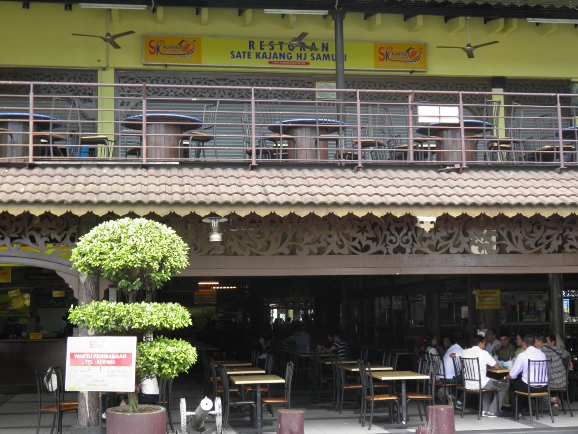
SATAY
Satay is one the country’s favourite foods. It consists of small pieces of seasoned meat or fish, skewered on a bamboo stick and grilled over charcoal. It is served with tangy peanut dipping sauce together with chunks of cucumber, sliced raw onion and ketupat (rice cake). Varieties of satay include beef, chicken, mutton, pork, fish, squid, prawn and rabbit. One of the most famous satay restaurants is Sate Kajang Haji Samuri, originally from Kajang (pictured above) but now with branches around KL.
SEA SLUG
Sea slug (also known as sea cucumber, bêche de mer or gamat) is a common ingredient in Chinese cuisine. Its medical benefits are highly acclaimed and when used as a health supplement it is said to help fight cancer, heal wounds, improve skin problems and treat impotence among other things.
SOY SAUCE
Soy sauce is the staple condiment and ingredient for all types of oriental cuisine. In Malay it is known as kicap soya, ‘kicap’ being the general term for all types of sauces and the origin of the word ‘ketchup’.Dark soy sauce has 10 times the anti-oxidants of red wine but drinking a glass full would not be healthy due to its high salt content. Worcestershire Sauce is known locally as angmo daoiu, which in Hokkien literally means ‘foreigners’ soy sauce’. Some believe that consuming soy sauce will darken the scar when one has a wound.
STINK BEANS
Stink beans (parkia speciosa) are known locally as petai. They look something like broad beans and their pods grow on large trees. Their name is due to their somewhat pungent aroma and, like asparagus, they cause urine to acquire a strong odour.Stink beans are said to be beneficial for health; they regulate blood sugar levels, are a natural laxative and improve mood. They are usually served as sambal petai, cooked together with garlic, chilli and belacan (shrimp paste).
SUGAR
Malaysians have a sweet tooth and the subsidised sugar price allows manufacturers and chefs to apply sugar liberally in their foodstuffs. This has resulted in an explosion of diabetes cases, at a rate even ahead of the global trend. To address this issue, a reduction of the sugar subsidy was announced in the 2012 budget, in the hope that manufacturers will reduce the sugar content of their soft drinks, juices and countless other products.
TEH TARIK
Teh-Tarik, a favourite local beverage, is basically hot tea with condensed milk and lots of sugar. It comes with a frothy head (like a cappuccino) which is created by pouring the drink into a glass from a great height. The pulling action which the vendors love to show-off while creating the froth accounts for the drink’s name (literally pulled tea).
This unusual method of serving tea helps to blend the condensed milk with the strong aromatic tea and helps to cool it down to a drinkable temperature.
TOFU
Stinky tofu, or Chou Taufu is really as bad as it sounds. It can be smelt a mile off - a combination of toilets, zoo and pig abattoir. Its diabolical odour is created by soaking tofu in brine which has been steeped in fermented vegetables, shrimp, meat and herbs for around six months! The fungus encrusted tofu is then cut into cubes and deep fried until the whole street reeks. The brown, crunchy cubes are served with a pungent sauce to mask the stench. Opinions are divided on how it tastes. Some say it tastes better than it smells (not difficult). Others say it tastes exactly how it smells. Either way, it is a popular dish and can be found in various street food markets around KL.
VEGETARIAN RESTAURANTS
With so many delicious meaty and seafood delicacies on display one might think that KL is not the easiest place in the world to be a vegetarian. But actually, there are lots of excellent vegetarian restaurants about thanks mainly to the country’s large Hindu and Buddhist populations. The canteen at the rear of Kun Yam Thong Temple in KL is reputed to serve a good veggie lunch.
WAN TAN MEE
This dish comprises springy noodles (made from egg and rice flour) served with beef or pork dumplings wrapped in wanton skin. The dish can be ordered dry or in a clear soup. It is usually served with sliced barbecued meat, shredded chicken and a few leafy vegetables. Pickled green chillies in soy sauce go well with this dish.
- Home
- Malaysia Trivia
- Malaysian Food Trivia
Share this page:




Comments
Have your say about what you just read! Leave me a comment in the box below.